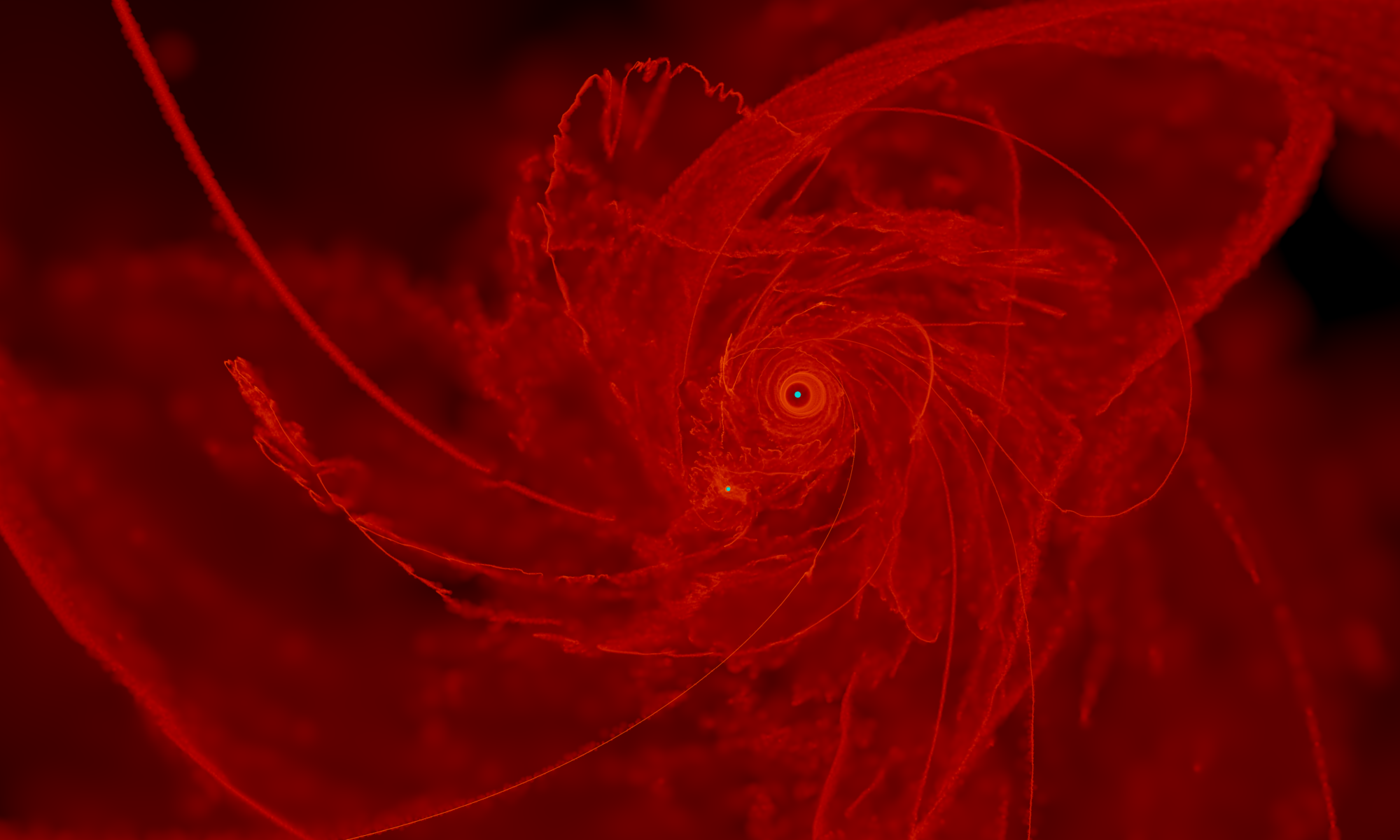My primary research interests are in high-energy astrophysical phenomena, with particular emphasis on relativistic motion, gravitational dynamics, radiation hydrodynamics, shockwaves and explosions, and accretion theory. Papers on these subjects can be found by following the link in the publications page, or you can read the more qualitative descriptions below of the phenomenology (i.e., the topics in astrophysics on which I work that incorporate the physical interests listed above). If you are an undergraduate or graduate student at SU and you are interested in starting research on one or more of these topics, please do not hesitate to contact me!
Tidal Disruption Events
Tidal disruption events (TDEs) occur when a star is ripped apart by a supermassive black hole — a gravitational behemoth that lurks in the center of nearly every galaxy. One consequence of the gravitational interaction that destroys the star is the formation of an accretion disc out of the tidal debris, which illuminates the center of the host galaxy in which the TDE occurs. We now observe these events dozens of times per year, and our observations can yield valuable information about, for example, the properties of black holes.
My research on TDEs concerns how we understand the tidal disruption process, the evolution of the tidally disrupted debris, and the formation of the accretion flow around the supermassive black hole; relevant papers include
- Discs from TDEs (with my graduate school advisor, Mitch Begelman)
- Stream fragmentation (with my collaborator, Chris Nixon)
- TDEs from Binary SMBHs (one of the simulations created the image on the homepage)
- Fallback from partial TDEs (when the black hole doesn’t quite destroy the star)
Radiation Hydrodynamics
We observe astronomical objects because of the light that they emit (and now we’re also “seeing” in neutrinos and gravitational waves). Often times and to a very good approximation the light emitted by an astronomical source doesn’t feed back and affect the physical evolution of the source itself. However, there are extreme situations where this is no longer the case, and the pressure associated with the radiation in a gaseous environment can crucially modify its dynamics. The interaction between radiation and matter in astrophysical flows is known as radiation hydrodynamics; see this excellent book on the subject.
My research in this area investigates how relativistic phenomena — objects moving at very nearly the speed of light — respond dynamically to the presence of an intense radiation field. I have focused mostly on the diffusive regime in which leading-order terms in the photon mean free path produce an effective viscosity within the fluid, which transfers momentum and energy to and from the radiation field. Relevant papers include
- Radiation-viscous hydrodynamics
- Viscous boundary layers (two stream and freely expanding jet)
- Structured jets
Failed Supernovae
Supernovae are the cataclysmic deaths of massive stars, and occur when the star exhausts its supply of nuclear fuel, its core collapses and forms a neutron star, and the neutron star “bounces” to launch a shockwave through the overlying stellar envelope. While nature seems to do this routinely, simulations find that the shockwave formed from the neutron star bounce tends to “stall,” or lose its momentum, deep within the star. If this stalled shock cannot be revived by, e.g., neutrino heating, the collapse of the stellar core fails to produce a supernova.
Interestingly, however, the loss of mass-energy that accompanies the formation of the neutron star — in the form of neutrinos that stream out of the star — still produces a dynamical response of the stellar envelope, albeit a much smaller one than a supernova. This low-energy shock can eject some mass and create a sub-luminous outburst that still may be detectable. I’ve worked on the hydrodynamics of this secondary shock formation as a consequence of neutrino mass loss. Relevant papers include
- Mass Ejection in failed supernovae (variation with stellar progenitor and analytic analysis)
- Weak shock propagation (self-similar solution and application to failed supernovae, stability analysis, numerical study)
Gravitational Dynamics
While two massive objects orbit about one another in closed elliptical orbits (when Newtonian gravity is at play), adding more gravitating objects into the mix creates a complicated — and often chaotic — dynamical system. Many-body gravitational dynamics can create phenomena such as hypervelocity stars, which are stars ejected from the Galaxy on runaway orbits, and the population of S stars, which are stars orbiting the supermassive black hole at the center of the Milky Way. I’ve worked on these gravitational dynamics problems in the context of hypervelocity star production and exotic tidal disruption events. Relevant papers include
